Time Slots
Resources can be subjected to a calendar. Administrators can manage the default schedule for resources within the organization. If configured, the planners will be able to see that in the resource zones area of the planning board:

This information is crucial for the planner to create a feasible planning and keep the resources healthy and happy. It shows the business hours, holidays and other arrangements (like night or holiday shifts) that are imposed on the resources. Administrators can - if needed - define a schedule for every resource via the calendar setup. Everything in the shaded color shows the unavailable time, which leaves the white areas with the working hours. This enables the planner to identify the availability of the resources and adjust the planning accordingly.
This is all well and good, but wouldn't it be nice if Dime.Scheduler could take care of this automatically? Absolutely, which is why Dime.Scheduler supports the possibility of automatically modifying the duration of the appointment, based on the resources (and its calendars) that were assigned to it. In other words, the time slots feature ensures that schedule of the resources is in accordance with their own calendar and availability, creating a realistic and feasible planning.
How it works
Dime.Scheduler has a built-in calendar system that can be used to automatically update the total duration of an appointment, based on the availability of the resource that is carrying out the task.
The total duration of an appointment is the sum of working time and nonworking time.
When the calendar mode is switched off, the nonworking time is always 0 and the working time equals the total duration. This implies that business hours and all other calendars settings are ignored.
When the calendar mode is switched on, the working time is the independent variable. Allow me to illustrate by using the example in this professional paint job:
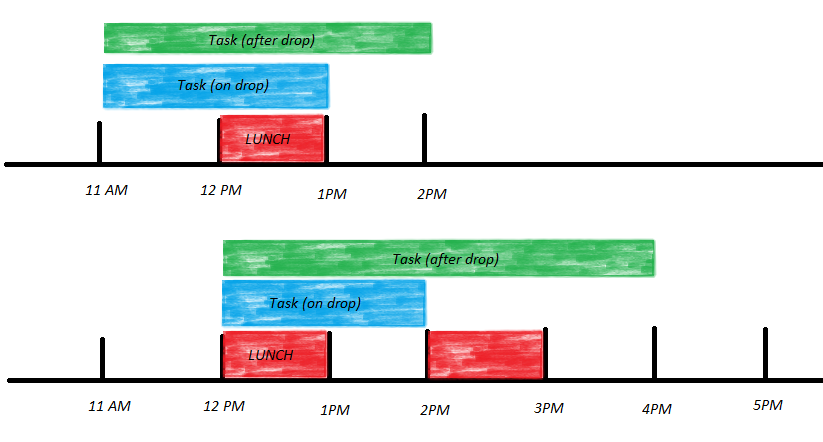
Let's assume that the default duration of a task that is dragged on the planning board is two hours, as specified in the FastTrack wizard of Dime.Scheduler connector extension for Microsoft Dynamics 365 Business Central:
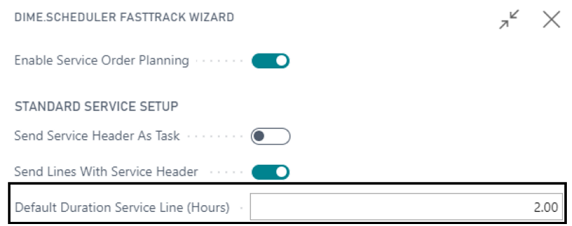
No matter how many hours it takes to complete a task, when a task dragged to the planning board, Dime.Scheduler will only take a two-hour slice from that task.
In this example, the task is dropped on the 11 AM mark. For a brief moment, the blue bar will be displayed in the planning board.
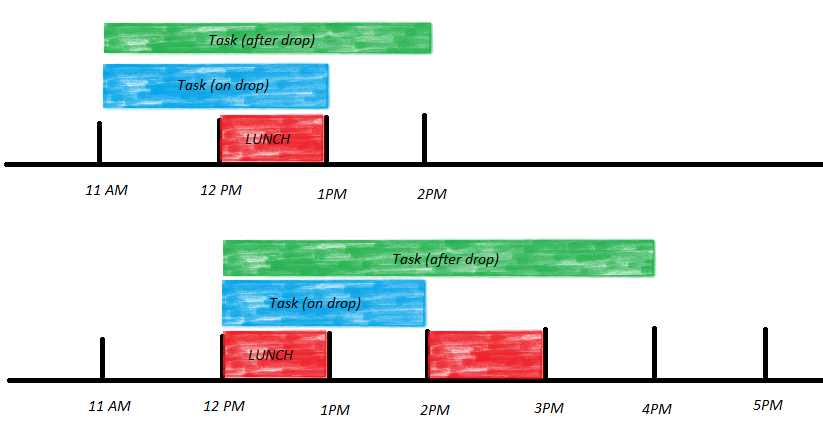
When the calendar mode is switched on, Dime.Scheduler’s algorithm will create a nonworking timeline and will keep adding time to the total duration until the appointment has just enough working time to complete the task. If the calendar from this example would’ve had a lunch break, then the appointment would’ve remained as it is – 2 hours. Since the resource does have a lunch break between 12PM and 1PM, the appointment needs to last longer for the task to complete. The working time between 11AM and 1PM is only one hour, so the algorithm will look for more working time later that day. This example is simple because there is available working time right after lunch. Thus, the total duration of this appointment is three hours, two of which are dedicated to work and one is used for lunch.

It is that simple, although complex calendars might create some surprising results, as the example below clearly shows. It’s a simple two-hour assignment but because of the nonworking time, the resource is only able to complete it at 4PM instead of 2PM.

It gets quite dramatic when a task can’t be finished before the end of the working day. Suddenly a two-hour appointment takes 17 hours, while the working time still remains two hours.

Configuration
Because this is such a pervasive feature and because not everybody wants it or needs it, it is entirely optional, hence configurable. This can be justified with a simple example. Suppose the planner needs to plan a task that requires ten hours of work. After finding a resource that can carry out the task, the planner finds out the resource needs to drive two hours to get to the location, which makes a dismal four-hour commute. The resource agrees with the planner to do two hours of overtime to finish the task instead of having to come back for two measly hours the next day. If the auto-extend feature couldn't have been turned off, the planner could not have overruled this decision in Dime.Scheduler.
There are three levels of configuration which will give ample support to finetune the auto-extend feature:
These three levels are cascading. All three levels must have the right values in order to apply the recalculation algorithm to the appointment. If any of the upper levels block the setting, the algorithm will not be applied.
Global configuration
The administrator can decide if the auto-extend feature must apply to everyone. If the administrator decides to disable this, all subsequent settings on a lower level won't have any effect. In the application setup, you will find a option that prompts to switch on the calendar mode:

Note that there are two other related configuration elements that are concerned with visualization: whether or not to visualize the resource calendars and if so, which color to use.
Planning board
The second level of configuration can be found at the planning board level. There is a button that achieves the same thing as the global configuration, but it is scoped down to that component only. This means you can have several planning boards in your profile with different calculation modes. Note that this icon will not appear if global configuration has switched off the calendar mode.

This button can be toggled. If the button's color is red, it means you want to ignore the auto-calculation feature on this planning board. Creating or updating appointments in this planning board will not apply calendars as such – even though appointments may indicate so. The value of this button is stateful.
Appointment
The third level of configuration can be found on the appointments and tasks. Appointments which are marked to ignore calendar application are shown with a small orange triangle at the left bottom corner of:
There are two ways to modify this value. Either through the appointment's context menu or through the editor, as shown here:
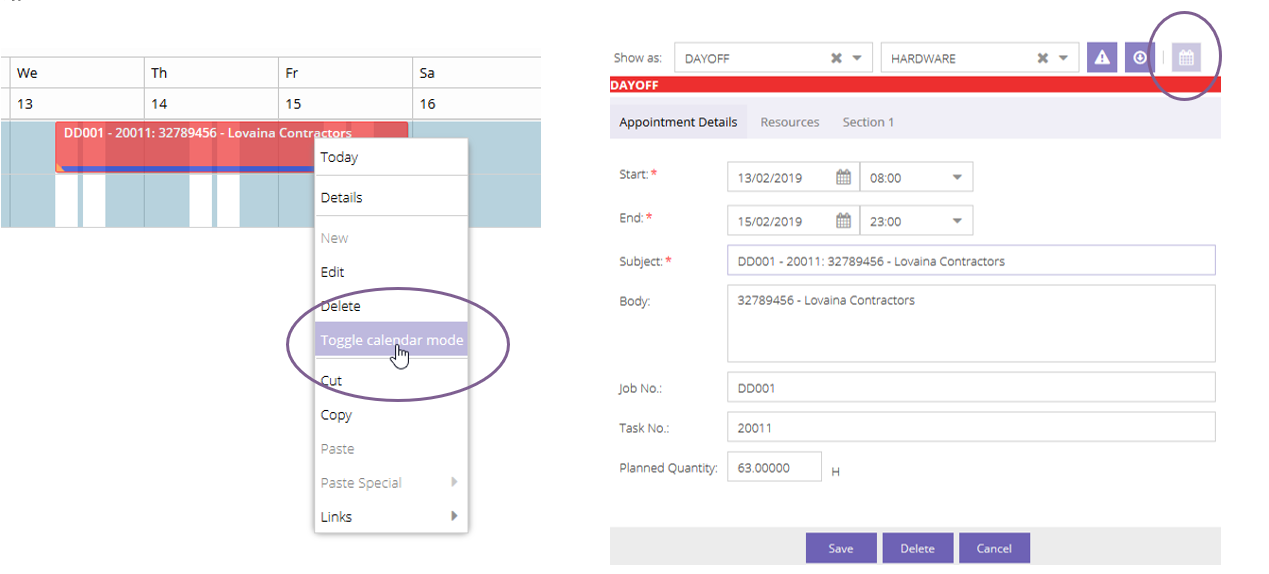
Conflict resolution
Appointments with more than one resource pose a challenge in that it is impossible to reconcile two different schedules (from the resources) to one appointment. Therefore, the planner must decide which resource to use for the automatic recalculation. When creating or updating such appointments, a resolution window will be prompted, such as this one:
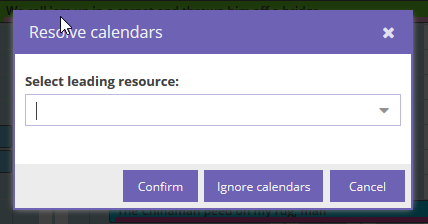
There are three outcomes:
- The planner selects the resource which will be used for the appointment recalculation
- The appointment ignores calendars altogether (no automatic recalculation)
- Cancel the update